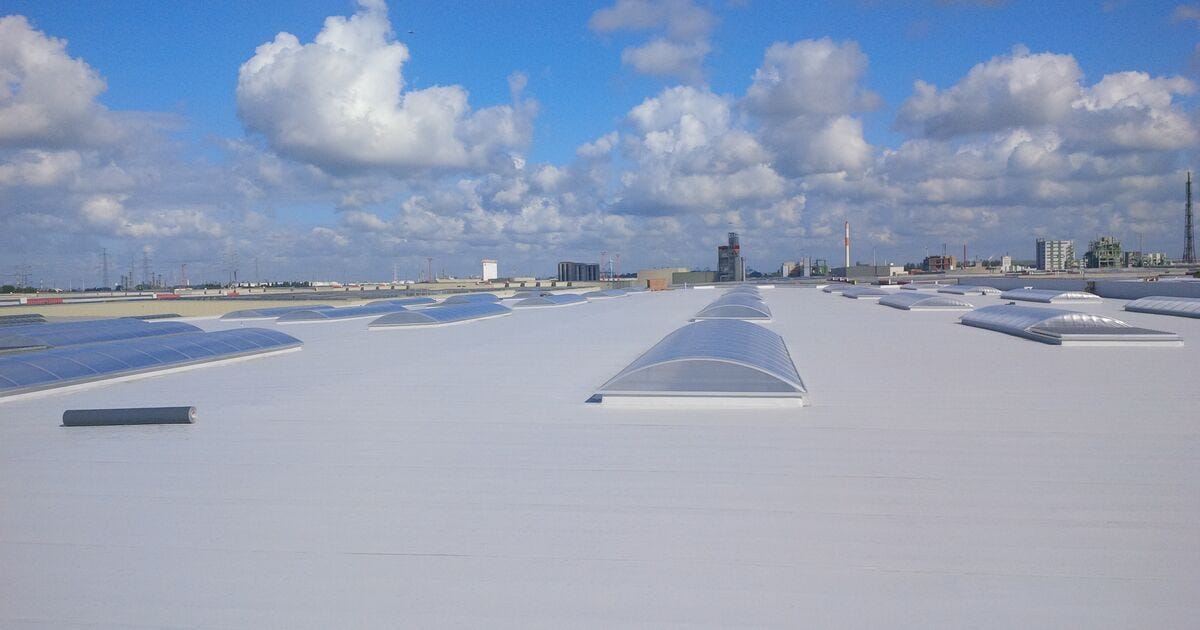
In Ireland, as energy-efficient buildings become increasingly important, a cool roof can play an important part in achieving certification to the LEED green building rating system. Also called cool roofs, as the name suggests, a cool roof reflects a significant portion of the sun’s rays away from a building, rather than absorbing and transferring the heat to the interior.
There are environmental and financial benefits to installing a cool roof. Traditional dark-coloured roofs absorb far more solar energy, causing a substantial buildup of heat within a building. This can trigger the need for higher air conditioning usage or increased ventilation, especially during warmer summer months. The white reflective surface of a cool roof reduces the ‘solar gain’, which can reduce reliance on air conditioning by 11-27% at peak times.
Reducing heat buildup in buildings
On a broader scale, cool roofs contribute towards reducing the ‘Urban Heat Island’ effect in cities. In Dublin and Cork, consultants Gamma studied satellite data and found industrial areas that produced excess heat compared to nearby rural locations.
In fact, commercial buildings are where cool roofs are mainly found; often in data centres or food manufacturing facilities to help keep the buildings cool all year round. They are typically used in new buildings, unless a refurbishment project specifically calls for reduced energy consumption.
And with researchers anticipating more heat risk in major urban areas over the coming years, it adds up to a compelling reason to consider specifying a cool roof. (It might seem like a distant memory now after a rain-soaked summer – even by Irish standards – but Met Éireann said June 2023 was the hottest June on record.)
Design considerations for effective reflective roofs
For architects and designers, there are no technical reasons not to implement a reflective or cool roof – although there are some design considerations to take into account. For a cool roof to keep working at its best, the goal is to try to keep it as white and as clean as long as possible.
Detailing is extremely important to ensure slopes and falls are all working correctly. There should be no traps where dirt can get stuck. Due to the high levels of rainfall in Ireland, the roof needs to have details so that the rain flows away.
Combining cool roofs with functional roofs
When it comes to designing a building with sustainability in mind, architects can combine cool roofs with all functional roof types, including green, blue and solar roofs to increase the positive impact the building has on the environment and to match the local building requirements, whether the goal is to increase biodiversity (green roof), help with water management (blue roofs) or increase the renewable energy production (solar roofs). It is very common for a building to have a mix of different roof types.
It’s possible to combine cool roofs, green roofs and solar roofs in a single project. It’s common for a building to have a mix of several types.
Soprema solutions for cool roofs
Regardless of which type of waterproofing an architect or designer wants to specify, Soprema can offer a bespoke cool roof waterproofing system to match the requirements of each individual project. We provide cool roof waterproofing solutions in bitumen – with SOPRASTAR capsheet; in liquids with ALSAN 970 CR - a white-pigmented reflective layer for the ALSAN PMMA ReflectRoof system; and in synthetics (PVC/TPO) - with our FLAGON ENERGY PLUS range of membranes.
To help comply with LEED version 4.1 (2019), the aged three-year Solar Reflectance Index (SRI) value for low-sloped cool roofs has to exceed 64. Soprema membranes and finishes are tested to give a rating on the SRI scale ensuring high solar reflectance values. For example, ALSAN 970 CR has an SRI of 108.
Examples of Soprema’s cool roof projects
Soprema supplied complete cool roof build-ups for several projects, including LEED Gold IPC House, LEED Gold 40 Molesworth Street and LEED Platinum DAA headquarters at Dublin airport, to name a few. Our complete cool roof waterproofing solutions are also used on several data centres, together with our revolutionary PV fixing system, FIX EVO, which does not penetrate or compromise the integrity of the waterproofing or insulation during installation or maintenance of the photovoltaic system. Cool roofs are an excellent choice when incorporating solar panels as they help the light to be directed towards the PV panel, rather than it being absorbed by the roof.
Get in touch
Want to find out more about our solutions, the technical services we offer, or to discuss how to incorporate Soprema systems in a specific cool roof project? Don’t hesitate to contact our technical experts who can advise on the best solutions, delivered on time, on budget and to the highest possible standards.

